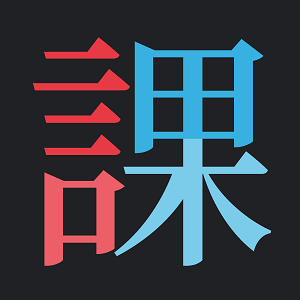課
부수: 言
획수: 15획
課 has the meanings academic subject, subject of an examination, subject area and task.

課 = 言 + 果
X = semantic + phonetic
• 言 depicts speech organs and represents the meanings ‘speech’, ‘sounds’ and ‘words’. This lead to the meaning ‘examine’.
• 果 gives the character its sound.
Evolution:
課 = to examine ➔ subject of an examination ➔ academic subject
課 = to examine ➔ subject of an examination ➔ task
言 =  + 口
+ 口
•  is a distortion of the original form (see below).
is a distortion of the original form (see below).
• 口 depicts a mouth.
言 was originally 舌 which depicts a tongue. From this comes the meaning ‘speech’.
果 = 田 + 木
• 田 is a distorted depiction of a fruit and only by coincidence resembles ‘field’.
• 木 is a depiction of a tree.
From the original meaning of ‘fruit’ came ‘result’ and thus ‘consequence’. Some scholars suggest 果 conveys meanings of ‘consider’ (as in ‘consider one’s words’) though this is questionable.
Mnemonic
Think of how 言 is used to mean ‘words’ and 果 possibly means ‘consider’. A student listens carefully and considers 果 what their teacher has to say 言.
Alternatively, think of how 果 can be used to mean ‘result’, ‘outcome’ or ‘fruition’. A lesson 課 and the teacher’s words 言 produce 果 understanding.
Vocab
| 課程 | 과정 | scholastic course |
| 課外 | 과외 | private lesson |
| 放課 | 방과 | class dismissal |
| 賦課 | 부과 | imposition of levy/penalty |
| 考課 | 고과 | evaluation of merits |
| 課稅 | 과세 | taxation |
| 課長 | 과장 | section chief |
| 課하다 | 과하다 | to assign a task; impose a levy |
| 課題 | 과제 | a task; assignment; problem |
| 課業 | 과업 | a task; duty |
| 日課表 | 일과표 | a daily schedule |
Other resources
Image searches
Google
Bing
Yahoo Japan
Baidu (click 图片)
Sogou
Pinterest
Flickr
CJKV
CJKV Dict
Wikitionary
Unihan Database
Korean
Chinese
Written Chinese
Arch Chinese
ZDic
CC-Canto
Chinese Text Project
The Chinese University of Hong Kong (etymology)
Chinese Boost
Japanese
Takoboto
Jisho
JLearn.net
Sakura
The Kanji Map
Sentence Search
Immersion Kit
Vietnamese
Bibliography
— Daum 사전, [s.v. 課].
— Grant, B.K. (1982). A Guide To Korean Characters: Reading and Writing Hangul and Hanja, [s.v. 1530]. Seoul: Hollym.
— Outlier Dictionary of Chinese Characters, [s.v. 課, 言, 舌, 口, 果, 田].
— Seely, C., Henshall, K.G., & Fan, J. (2016). The Complete Guide to Japanese Kanji: Remembering and Understanding the 2,136 Standard Japanese Characters, [s.v. 456]. Singapore: Tuttle Publishing.